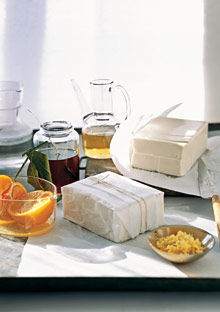The Tastiest Tofu Dish Ever

Photo: Beatriz da Costa
We've been told we're supposed to eat it, but, er, why exactly? And the more challenging question—
how? We were totally stymied by this pale, bland, flavorless block of food until discovering that with a few
spices, braises, and blackened pans, tofu was actually incredibly delicious.
It was, and also wasn't, love at first site. Michael roller-skating past me on his way to Buddhism 101: yes. Tofu: no. We were college students, living in a vegetarian co-op called the Zoo, where everybody doused themselves in patchouli and self-righteousness and cooked from recipes that began: "Cut the block of tofu into slabs." Slabs. Really, it just doesn't set the mouth to watering. ("Cut the whale blubber into slabs." "Begin with a slab of granite.") When you got home from class, there would be ten pounds of tofu lined up on the kitchen counter, all those pale cubes bobbing around in water like some kind of vegan aquarium. The cookbook would be open to tofu tetrazzini or tofu Parmesan or tofu stroganoff, and some optimistic young hippie would be padding around in his moccasins, whistling to Phish and gathering tubs of sour cream and oregano. But here's a little secret about cooking a slab of tofu: No amount of sauce is going to conceal it. It's like a toddler playing peekaboo by draping a washcloth over her head: "Um, yeah—I see you." Watch that same toddler actually eat raw squares of tofu, and you'll understand more about your own fear and loathing. It's not the fact that it ends up in her hair, which could happen to even the most honorable of foodstuffs—chocolate, say, or duck confit. It's that preternatural whiteness (evocative only of Wonder Bread), the fact that it's cut up into perfect cubes (evocative only of dice), or that jiggling sponginess (evocative of nothing else on earth). Or the damning phenomenon of her swallowing it happily, a toddler's way of announcing: "Huzzah! This has no discernible taste!" And yet it's not even just a simple absence of flavor—it's an oddly beany absence of flavor.
Oh beany blandness! So seemingly benign, yet a force to be reckoned with. Because tofu's blandness isn't simply impenetrable—it conquers everything around it; it's like some kind of imperial blandness. Which sounds like something you might get—and enjoy—at a Chinese restaurant: "Imperial blandness with ten flavors." You like tofu in Chinese restaurants because it's usually been deep-fried first, and deep-frying is the key to all wonderfulness. But there's something not quite right about putting two gallons of oil up to boil because you want to eat a healthy dinner. And yes, that's why you got the tofu in the first place—it's good for you. It's high in protein, low in bad stuff, and full of promises of the cancer- and cholesterol-fighting kind (see What Is Tofu, Anyway? ). If you're a meat eater, your poor heart needs an occasional break from all that yummy, bad saturated fat. When Michael and I were finally cast from the Zoo into "the real world," where you could not spend the afternoon rolling spicily around in bed while somebody else prepared your bland dinner—well, tofu was something we had to learn how to cook.
Like soy scientists, we tried to unlock the Mystery of the No Taste. The problem with regular cooking methods, we decided, was that beneath the veneer of sauce, the tofu remained intractably insipid. How could you make the tofu take up taste? We tapped our mental clipboards. Wasn't there some law of physics to help us? Economy of matter? What if you cooked slices of tofu in a highly seasoned liquid until the liquid disappeared? All that flavor would have to go somewhere—and the only place to go, we hypothesized, would be into the tofu. Indeed.



